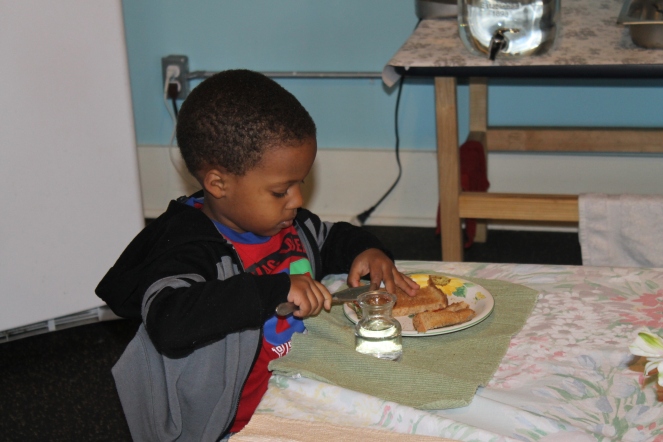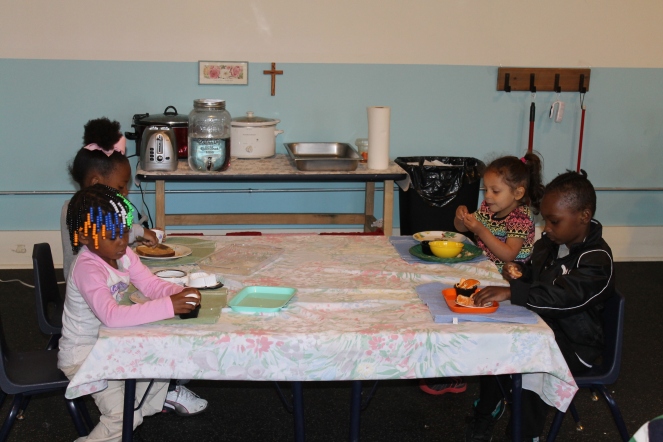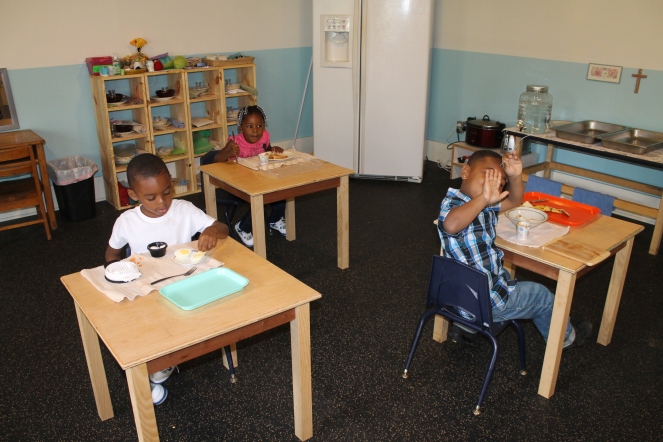Yesterday I had the very pleasant experience of being able to work in the classroom alongside the children.
We had a very wild morning so we decided to play outside first, and then work in the afternoon (typically we work in the morning, play outside, then eat lunch). So we played on the playground for a while, then came inside and told the kids that we were going to have our “Work Cycle” now, and that if they wanted to choose to eat lunch (rice and beans) as their work, they could. (Usually we eat “family style” – all together – so this was a change from the routine.)
Some of the kids chose lunch, some chose to do our regular food prep works (bananas, strawberries, toast, etc), and some chose non-food related works. It was one of those rare and lovely times when everyone was working and my presence in the room was completely superfluous. I was also hungry, and no one was doing the “Boiled Egg” work (a work we have on the shelf every day in our Practical Life section), so I decided to do it.
The kids chuckled at me doing my own work, but then we all went about our business and worked together in harmony. My assistant also decided to choose “lunch” as her work, and she set up her placemat and plate on a table in the corner and helped herself to rice and beans from the crockpot.
Now this was quite fun for me and also very interesting – because I got to experience firsthand just exactly how much work it actually is to do this Boiled Egg work! From start to finish, it took me about twenty minutes to do this work. I’ll explain the details in a minute but first a little theory behind the importance of something like eating boiled eggs in a classroom of 3-6 year olds.
Maria Montessori claimed that “The first essential for the child’s development is concentration. It lays the whole basis for his character and social behavior. He must find out how to concentrate, and for this he needs things to concentrate upon… no one acting on the child from outside can cause him to concentrate. Only he can organize his psychic life. None of us can do it for him.” (The Absorbent Mind, pg 201).
That’s a pretty huge claim – that the ability to concentrate forms the foundation not only for the child’s academic life, but for the entire formation of his character and social behavior. Why?
It’s obvious that children (or adults) need to be able to concentrate in order to complete homework, projects, get good grades, etc. But what Montessori discovered is that concentration is not only an academic skill – concentration is the gathering of the “psychic powers” of the human, particularly the small child, and knowingly, consciously putting them toward a specific task. The task does not have to be academic; it can also be spiritual, emotional, social.
A child who moves from thing to thing in a classroom or home environment, never concentrating on any one thing for more than a few seconds (or even a few minutes), will also not be able to focus on the needs of another child in his environment. A child who cannot gather herself enough to put her hands to work peeling a boiled egg without becoming distracted, will also not be able to gather herself enough to write a paragraph or short story or essay or any other assignment. A child who cannot focus on the movements of his or her body well enough to coordinate them to walk from here to there without dropping and breaking the glass pitchers or serving dishes in their hands, is also going to have a difficult time calming themselves and their bodies in the midst of an argument or disagreement or some other external excitement.
This is the entire reason behind the activities in Practical Life in the Montessori classroom. Through the Practical Life works, we provide the children with real objects and real opportunities with real pay off (and real natural consequences), to help them create in and for themselves the capacity to concentrate. To concentrate on what? On the present moment. On reality. On their bodies. On what they are doing with their hands. These “works” as we call them give them external motivations and opportunities to gather together their internal powers for the purpose of one task – thus helping them to create, for themselves, the capacity to concentrate, focus, and to bring their body into unity with their mind.
Sometimes I can get discouraged in my class because we do not yet have a lot of children doing advanced “academic” works like composing paragraphs with the moveable alphabet or doing advanced math like discovering the foundation of the decimal system or multiplication tables. (See the pictures below for examples of what 2nd and 3rd year Montessori students start doing.)
But yesterday I was reminded that my children are not doing these things yet, because they have spent this year building their capacity for concentration. Concentration is the basis of all of these more advanced works. And my children have come SO FAR in this regard! At the beginning of the year, my assistant and I were TOTALLY overwhelmed because within 10 minutes in the morning, every activity was off the shelf, mixed up, and all of the children had touched every work (without completing any of them) and were bored already and ready to go outside for the rest of the day.
We had NO idea what to do. Because we realized what Montessori already knew – we simply could not force them to concentrate, could not force them to sit down with a work and complete it. This had to come from the child’s own will. And all we could do was provide them with enticing works in their environment that would invite them to create for themselves this longer capacity to concentrate. So we went to WORK building so many “works” in Practical Life – mostly our food prep shelf (since what is more enticing than food!).
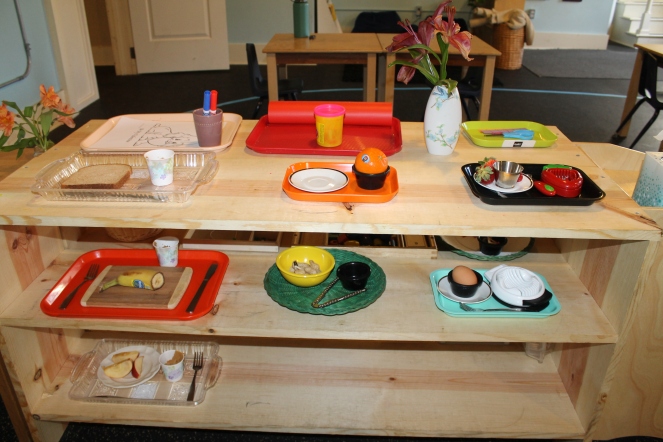
Yesterday, as I did my own work from the food prep shelf, I realized just how much concentration it takes to complete this work. And I was so pleased to realize that every single child in my class now is capable of this! The boiled egg work is one that every child in my class knows how to complete and can complete on their own – even my MOST distracted kiddos. As I was doing this work, the children were all around me doing their own work, independently. It was so special.
So without further ado I want to walk you through this work, just so you can see for yourself how much concentration, focus, AND sequential thinking and working this activity takes (so you can see that as the children are building the capacity to concentrate, they are also building their memory, ability to think and work sequentially, and their fine motor skills – all “academic” skills that are absolutely necessary).
I have drawn a diagram of the movement of this work, so you can also get an idea of the level of concentration these kids have developed! Concentration doesn’t necessarily mean sitting silently like a robot working on one task. In a 3-6 year old classroom, it means LOTS and LOTS of movement, but the ability within all of that movement to remain committed to completing one task.
OK…. Here goes!
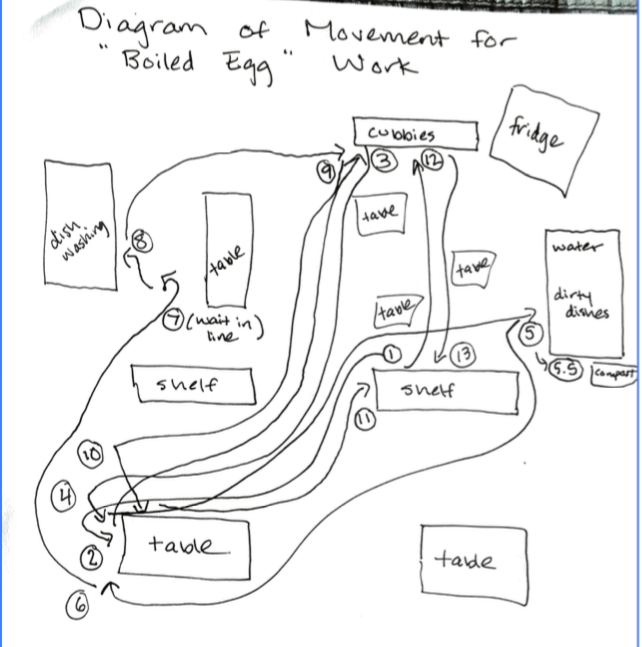
- Choose “Work” from the shelf – “Boiled Egg” in this case
- Carry work to chosen work space (table).
2.1. Set work down on table - Walk to cubby to retrieve place mat
- Return to table; unroll placemat
4.1 Set up work on placemat (take each item off of tray – egg; plate; fork; egg slicer)
4.2 Crack egg
4.3 Peel boiled egg, putting all pieces of egg shell in the small bowl which is designated for compost
4.4 Once egg is completely peeled, place it in the egg slicer
4.5 Slice the egg! (Most satisfying part of this work)
4.6 Using a fork, move each sliced piece of egg from the egg slicer to the plate
4.7 Eat the egg! (Using your fork!) - Once finished eating, take the fork to the dirty dishes
5.1 (Also take the bowl of egg shells to the compost and empty) - Return to the table with the (now empty) bowl for compost.
6.1 Set the bowl back on the tray
6.2 Pick up plate and walk to the dishwashing station - Wait in line behind other children washing their dishes (a great time for chatting!)
- Wash your plate
8.1 This involves first, dipping the bowl in the soapy water and using the scrub brush to scrub any dirty spots
8.2 Once all of the food is rinsed off the dish, return the scrub brush to its bowl and transfer your plate to the clean water
8.3 After rinsing off all of the soap, use the towel to dry the plate - After the plate is clean, return it to your cubby (or in this case, simply take it back to the table and put it back on the tray)
- Return to the table and set the work back up on the tray exactly how you found it – plate with bowl for compost on top (left side of the tray), clean egg slicer on the right side of the tray.
10.1 Also roll up your placemat to be returned to your cubby. - Return the tray to its spot on the shelf
- Go back to the cubbies to return your placemat, and also get a clean fork to put on the tray so that it is ready for the next child.
- Put the clean fork on the tray.
- Choose your next work!
So you can see it is quite a task! With lots of steps involved, a pretty huge time commitment, and MANY MANY opportunities to build concentration, fine motor skills, personal responsibility, sequential thinking and working, order, and connection to reality and the present moment. I’m so proud of all of our children who are developing all of these “powers”!
Enjoy some pictures of our kids doing the food prep works. Also, enjoy the video of a little girl at work in TOTAL concentration. Notice how she continues working despite everything else going on around her – even when people come to her table and specifically try to distract her!
